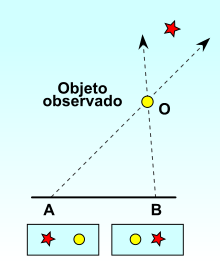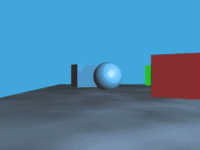Parallax

By projecting the object observed or against a sufficiently distant background, the position of O varies according to the point of view in A or B. From A, the observed object seems to be on the right side of the distant red star, while from B it looks to the left of that one.
The AOB angle is called parallax anglewhich covers the AB segment from O.
The parallax (from the Greek παράλλαξις [parálaksis], 'change', 'difference') is the angular deviation of the apparent position of an object, depending on the chosen point of view.
In astronomy
In astronomy, various types of parallax are defined. These are some:
- The to relax is the angle formed by the direction of two visual lines relating to the observation of the same object from two different points, sufficiently separated from each other and not aligned with it. This term is also used to refer to the distance to stars.
Annual parallax
The annual parallax is the maximum apparent value that the position of a given star can acquire in the course of a year due to the variable position of the Earth in its orbit around the Sun and that will correspond at the moment when the ecliptic longitude of the star, which is always constant, differs 90° from the ecliptic longitude of the Earth, which is constantly changing.
In the year 1838, Friedrich Bessel was the first to determine the parallax of a star, 61 Cygni, in the constellation Cygnus. Two years later, in 1840, Friedrich Georg Wilhelm von Struve managed to measure the parallax of Vega in the constellation Lyra.
The stellar parallaxes are below the second of arc. The closest star system to Earth is Alpha Centauri, a system made up of three stars. The closest of these, Proxima Centauri, has a parallax of 0.765", corresponding to 1.31 pc, or 4.3 light-years.
At a greater distance, the parallax is less, and the errors made become more and more significant, so that from 100 light years onwards the trigonometric annual parallax is no longer reliable to determine stellar distances.
Geocentric parallax or daytime parallax
The geocentric parallax or diurnal parallax is the difference between the direction of a star, seen from a point on the Earth's surface (topocentric) and the same direction of that star seen from the center of the Earth (geocentric).
Horizontal parallax
The horizontal parallax is the angle at which the radius of the Earth would be seen from a star when it is on the horizon. If the observer is located on the equator, then this parallax receives the special name of "equatorial horizontal parallax". The value is maximum at the Earth's equator and varies with latitude, since the Earth is not completely spherical.
Trigonometric parallax
The trigonometric parallax is the angle at which the radius of the Earth's orbit is seen from a star at a standard distance of one astronomical unit. It is expressed in seconds of arc. The distance to the star is the inverse of the trigonometric parallax expressed in parsec; that is to say that when it is said that the parallax of Antares is 0.019", it means that Antares is 52.632 parsecs or 171.66 light years away.
Solar parallax
The solar parallax is the angle at which the equatorial radius of the Earth is seen from the center of the Sun. It is equal to 8.794148".
Moon parallax
The lunar parallax is the angle at which the equatorial radius of the Earth is seen from the center of the Moon. worth 57' 2,608".
In photography
In photography, parallax determines that what is captured by the photographer through the viewfinder does not match the image captured through the camera lens. This parallax scrolling can be vertical, horizontal or both at the same time.
In this sense, the "parallax error" occurs when using a scope that is not mounted on the same axis as the objective. That is, the viewfinder does not preview the image itself that the lens offers it.
In these cases, when the viewfinder is displaced with respect to the lens, the image offered by the viewfinder is not exactly the same as the one that will later be reflected on the film (the one that captures the lens), but will be minimally displaced well in its horizontal axis, either on its vertical axis, or on both.
Parallax error occurs in older compact cameras, where there is a separate viewfinder from the lens to frame the image before taking the photo. In a single-lens reflex camera there is no parallax error, as the photographer views the image through the lens, reflected from the mirror to the pentaprism and viewfinder.
This type of error also affects the human eye; if it is not at the height of the observed object, false images can be perceived. In laboratories, this error must be taken into account, because when filling test tubes or other volumetric containers, if they are not observed from the correct height, the amounts of matter are poorly appreciated, with the consequent errors in the calculations.
The parallax is greater the closer the object to be photographed is, while from several meters the effect becomes insignificant. For this reason, when framing a photo of something that is nearby, parallax must be taken into account to avoid part of the image being cut off in the photo. The best precaution is to frame the photograph with extra margin on all sides.
Parallax Mirror
In analog measuring devices (using a needle or hand) a parallax mirror was placed in the form of a circular crown segment inserted in the dial of values. For the correct reading, the needle had to hide its own reflection (the observation was made by closing one eye).
Contenido relacionado
Otto von Guericke
Alternating current
Higgs mechanism



